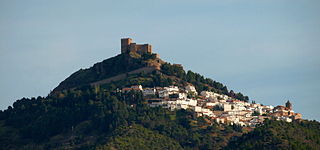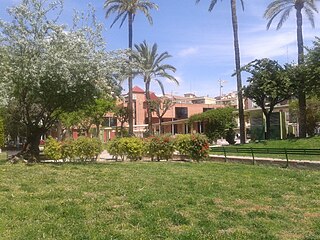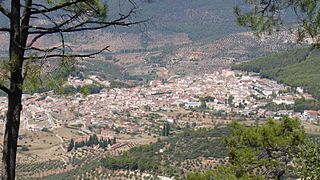
Alicante is a province of eastern Spain, in the southern part of the Valencian Community. It is the second most populated Valencian province. Likewise, the second and third biggest cities in the Valencian Community are located in this province.

The Biobío Region is one of Chile's sixteen regions. With a population of 1.5 million, thus being the third most populated region in Chile, it is divided into three provinces: Arauco, Biobío and Concepción. The latter contains its capital and largest city, Concepción, a major city and metro area in the country. Los Ángeles, capital of the Biobío Province, is another important city in the region.

Al Hoceima is a Riffian city in the north of Morocco, on the northern edge of the Rif Mountains and on the Mediterranean coast. It is the capital city of the Al Hoceïma Province. It is situated in the territory of the Ibaqouyen and Aith Ouriaghel tribes of the Rif region, who speak a Riffian variety of the Berber language locally called Tmaziɣt or Tarifit. The city is a known tourist destination despite its small size. It has a population of about 56,716 according to the 2014 census.

Talca is a city and commune in Chile located about 255 km (158 mi) south of Santiago, and is the capital of both Talca Province and Maule Region. As of the 2012 census, the city had a population of 201,142.

Orihuela is a city and municipality located at the feet of the Sierra de Orihuela mountains in the province of Alicante, Spain. The city of Orihuela had a population of 33,943 inhabitants at the beginning of 2013. The municipality has a total area of 367.19 km2, and stretches all the way down to the Mediterranean coast, west of Torrevieja, and had a total population of 92,000 inhabitants at the beginning of 2013. This includes not only the city of Orihuela, but also the coastal tourist development hub of Dehesa de Campoamor with 33,277 inhabitants (2013) and a few other villages.

Algueña or L'Alguenya is a Spanish municipality located in the Alicante province, in the comarca of Vinalopó Mitjà. Its climate is arid Mediterranean.

Busto Garolfo is a comune (municipality) in the Metropolitan City of Milan of 13 978 inhabitants. Busto Garolfo is located in the Italian region Lombardy, placed about 25 kilometres (16 mi) northwest of Milan.

Segura de la Sierra is a small village in the province of Jaén, (Spain), that belongs to the region of Sierra de Segura in eastern Andalusia.

Quart de Poblet is a municipality in the comarca of Horta Oest in the Valencian Community, Spain. It has 25,499 inhabitants.
Bigastro is a municipality in the Valencian Community (Spain) situated in the south of the province of Alicante, in the comarca of Vega Baja del Segura. It had a population of 6,450 at the time of the 2005 census.
Daya Vieja is a municipality of the Valencian Community (Spain), situated in the south-east of the Province of Alicante, in the comarca of Vega Baja del Segura.

Beas de Segura is a town located in the province of Jaén, Spain. According to the 2009 census (INE), the town has a population of 5,591 inhabitants.

Cazorla is a municipality of Spain located in the province of Jaén, Andalusia. According to the 2006 census (INE), it had a population of 8,173 inhabitants.

Chilluévar is a city located in the province of Jaén, Spain. According to the 2006 census (INE), the city has a population of 1629 inhabitants.

Brazacorta is a municipality and town located in the province of Burgos, Castile and León, Region of Ribera, Spain. According to the 2007 census (INE), the municipality had a population of 75 inhabitants.

Molina de Segura is a municipality of Spain in the autonomous community and province of Murcia. It is located 10 km from the provincial capital, Murcia.

The Region of Murcia is an autonomous community of Spain located in the southeastern part of the Iberian Peninsula, on the Mediterranean coast. The region is 11,313 km2 (4,368 sq mi) in area and had a population of 1,511,251 as at the start of 2020. About a third of its population lives in the capital, Murcia, and a seventh in the second city, Cartagena. At 2,014 m (6,608 ft), the region's highest point is Los Obispos Peak in the Massif of Revolcadores.

Siles is a Spanish town and municipality in the province of Jaén, in the autonomous community of Andalusia, located in the region of Sierra de Segura, bordering the province of Albacete. It has a population of 2,451 inhabitants according to the last available census (INE2011). Much of the municipality is located within the Natural Park of Sierra de Cazorla, Segura and Las Villas. Because of its location it is a mostly forest town near the river, farmland focusing mainly olive grove, in a strip of southwest-northeast direction including the vicinity of the town center and the municipal enclave that owns the town northwest of the region.
Valencians are the native people of the Valencian Community, in eastern Spain. Legally, Valencians are the inhabitants of the community. Since 2006, the Valencian people are officially recognised in the Valencian Statute of Autonomy as a nationality "within the unity of the Spanish nation". The official languages of Valencia are Valencian and Spanish.

Redován is a municipality in the comarca of Vega Baja del Segura in the Valencian Community, Spain.



















